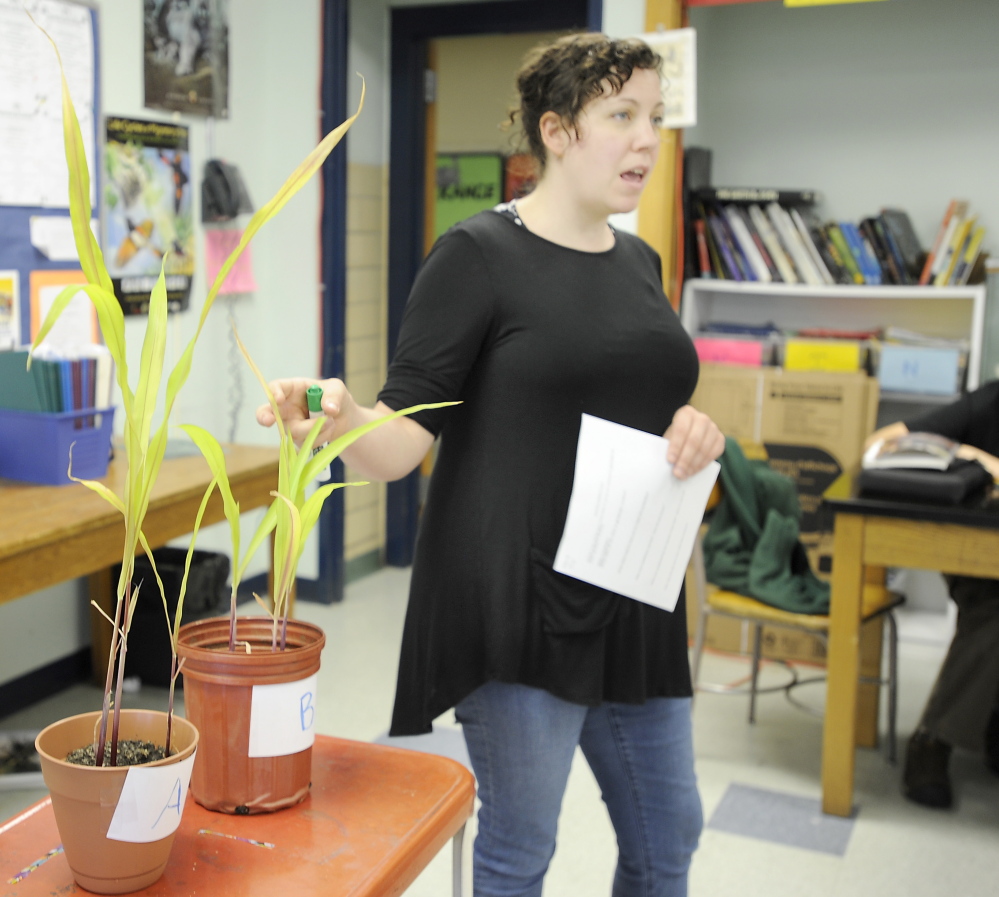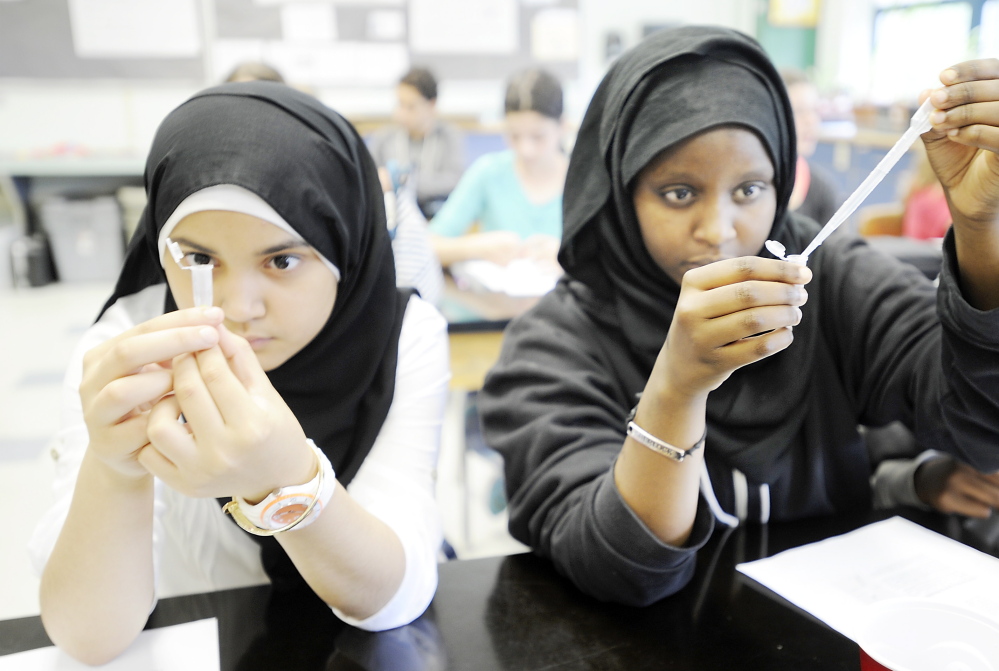Plant A stood tall at the front of the room, nearly twice the height of Plant B, but Plant B looked possibly healthier, its hues of greens brighter, fresher. King Middle School science teacher Catherine Bursk stood back and asked her seventh-grade science class to cast their votes: Which of the two did they think was grown from genetically modified corn seed?
They happen to be experts on the subject. Since March 31, Bursk’s students have been immersed in the world of genetically modified organisms, or GMOs. It’s the first time King, an expeditionary learning school focusing on in-depth studies that cross disciplines, has tackled GMOs as one of its “expeditions.” It was Bursk’s idea, inspired by Gov. Paul LePage signing Maine’s 2014 bill calling for the mandatory labeling of any foods made with GMO ingredients. Her upcoming curriculum was supposed to tackle genetics, and what better way to do it then with something both topical and controversial? “I felt like it was relevant to their lives,” she said.
Twelve students voted for Plant A to be the GMO corn. Eight raised their hands on behalf of Plant B. Those votes were cast on the basis of hunches, but then Bursk gave them instructions on how to know for sure. Half the room was given a tiny sliver of Plant A and the other half got pieces of Plant B. All of them mashed their pieces up in a vial, using a plastic pestle.
GMO corn is resistant to the herbicide glyphosate, originally manufactured by Monsanto and known then by its commercial name, Roundup. Glyphosate stops a plant’s ability to grow – weeds being the target – by inhibiting an enzyme known as EPSP-synthase. (This would be the dreaded item on a spelling test: 5-enolpyruvyl-shikimate synthase.) A GMO corn plant would contain an extra boost of the EPSP-synthase, allowing it to withstand the glyphosate and thrive.
Using a syringe, Casarra Abeasi, 13, and Akual Majok, also 13, tentatively added water to their pulverized leaves. On a shelf running under the window was a row of pots, some filled with flourishing seedlings, others not so much. These belonged to the students.
“Those are her (Bursk’s) plants,” Majok explained, pointing at Plants A and B.
The jury was already in on Majok’s plants. The students had doused their seedlings in Roundup the week before (they wore goggles and gloves) and now Majok had one happy corn plant, one pot containing a seed that had never germinated and two other plants that could only be described as sad. They were brown, they were limp, they were done. “You see how once we applied the Roundup, it died?” Majok said.
Bursk passed out test strips to the students and directed them to dip the test strips in the combination of water and pulverized leaves. If the plant contained the modified enzyme, then two lines would soon appear on the test strip. One, a control line, would indicate the strip was working and the other would indicate the presence of the boosted EPSP. The test wouldn’t work on food, Bursk explained, because the protein would have been broken down by processing. But a farmer could use it on her or his crop; so could a scientist working on genetically engineered plants in a lab.
As the results rolled in, the students were surprised; Plant B, the one just eight of the students had voted for, was the GMO plant.
“So even though a plant may look genetically modified – or not – doesn’t mean it is – or isn’t,” Bursk said.
For some students, GMOs were entirely new territory. In the early days of the project, the students watched the 2013 documentary “GMO OMG.” After that, Bursk said, “There was a lot of ‘Monsanto is evil.’ ”
But others came into the expedition with at least some opinion about GMOs. Simon O’Connor, who had prepared a project on the “flounder tomato,” which was genetically engineered with a gene from a fish to be able to withstand freezing temperatures and remain intact during transportation, said he hadn’t had a negative perception of GMOs. As he learned more, he became more confident of that perspective, and indeed, became a fan. “I believe they are what is carrying this country, really,” he said, citing low food costs and factory farming. His counter to Maine’s labeling law, which as written now won’t go into effect until five of the six New England states have similar laws in place: “If (foods) have high-fructose corn syrup in them, they have GMOs in them,” he said. “So technically, you can already tell.”
The students went to Trader Joe’s, Whole Foods and Save-A-Lot on scavenger hunts, looking for GMO ingredients. “What they found was it could be very difficult to find a product without those ingredients,” Bursk said. Including in their favorite foods: “When I told them that they were all derived from corn, it made them realize how prevalent GMOs are,” she said.
In their other classes, like social studies, the students studied political cartoons that related to the controversial GMO issue; they read Michael Pollan’s book “The Omnivore’s Dilemma”; writer and Maine resident Caitlin Shetterly, whose article in the August 2013 issue of Elle magazine linking GMO corn to allergy and autoimmune epidemics inspired her forthcoming book on the subject, paid a visit to the class. They analyzed newspaper stories about GMOs for fairness. “You can get lost in all the bias and propaganda,” Bursk said. “Having them learn that is something that they can apply to any controversial situation.”
For Bursk herself, teaching the class was a learning experience. She assumed she’d be anti-GMO. Instead, she sees the gray areas and the potential in GMO foods like the so-called golden rice, a rice enriched with beta-carotene to boost nutrients, particularly for populations of impoverished countries. “I think (GMOs) can be done responsibly.”
“What makes it interesting to me is that there isn’t a clear answer,” she said.
Send questions/comments to the editors.





Success. Please wait for the page to reload. If the page does not reload within 5 seconds, please refresh the page.
Enter your email and password to access comments.
Hi, to comment on stories you must . This profile is in addition to your subscription and website login.
Already have a commenting profile? .
Invalid username/password.
Please check your email to confirm and complete your registration.
Only subscribers are eligible to post comments. Please subscribe or login first for digital access. Here’s why.
Use the form below to reset your password. When you've submitted your account email, we will send an email with a reset code.